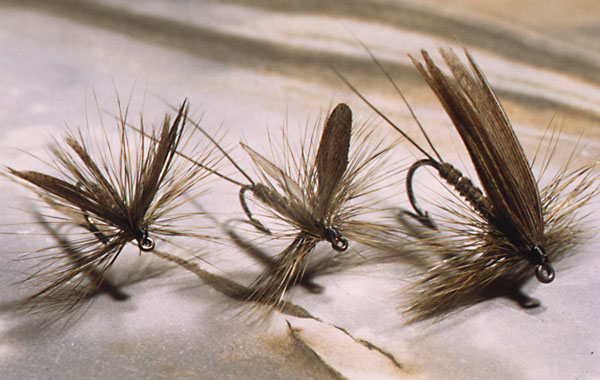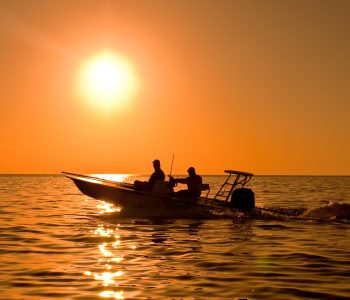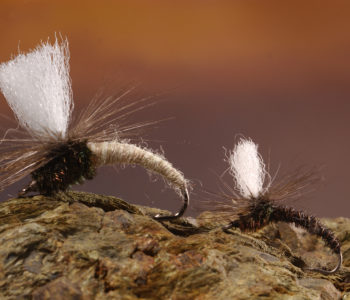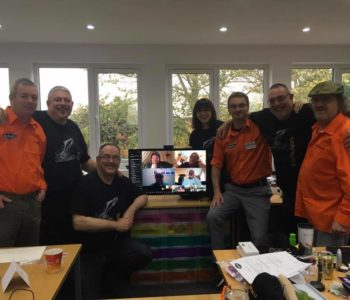
THE GREEN GLOMMA DUNS
The summer of 1990 involved much experimentation, especially when it came to grayling fishing, for I had plenty of new ideas to try out and investigate. I had collected several insects to evaluate and record during the wintertime from my Scandinavian trips of 1989. Most of the insects I collected where small Stonefly nymphs, Caddis larva and Mayfly nymphs. It was quit simple to keep the insects in excellent condition by storing them in an alcohol solution, which was concocted by my wife. I preserved the adult Sedges in small, airtight tubes with reasonable success. I unfortunately was unable to preserve the adult Mayflies for long, but still long enough to make some very good notes during my holiday.
The winter of 1989/1990 was reserved for attempting to tie several flies, which looked almost exactly like the actual insects. My priority was to create some good looking and effective Mayfly patterns. In this article, I will present a series of Dun imitations, with which, after extensive research, I was satisfied. I am not an expert in entomology, and any knowledge I have gained thus far is due to the efforts of several of my English friends. They proved to me how important it is, when fishing, to know exactly which insects are hatching at that moment. I think I did very well when all was said and done, because when I tried those patterns in the spring and summer of 1990, “91 and ’93, I caught plenty of fish during the natural hatches.
It was very important to me to try my new patterns during the periods that the Grayling were feeding on hatching insects, because, during some of these hatches, my Klinkhåmer has occasionally failed to produce.
My second problem was to find a tying technique, which would allow my flies to float well in the strong current of the wild rivers in which I prefer to fish. I put the most effort into the development of a fly which would float well and land perfectly. Two months later, when I was selecting some slides from my Light Tan Series for a lecture, I got a marvellous idea as a result of a lucky accident. A few of my slides were situated the wrong way in the cassette. By observing the flies at that angle, I saw an excellent opportunity to try a different technique for cutting the hackles at the bottom. Personally, I don’t like cutting off hackles. The floatability of the fly is affected in fast water, which creates an undesirable situation for a riffle fisherman like me.
I don’t like to fish with a large collar hackled dry fly (except for salmon and sea trout) because I prefer to fish in the surface film. Therefore, I have used mostly parachute flies, and deep surface floating emergers for several years, For the past few years, I have used a Swedish technique which involves tying up the bottom hackles with the tying thread just before I tie off the fly. With the new technique that I use now, I get the same result, but I get a more durable fly. The second benefit is that the fly is less complicated, and therefore much easier to tie.
I have tested all my Glomma Dun patterns extensively, and with considerable success during the last three seasons. The flies land perfectly, and the floating properties are superb! I have found that with this technique, flat winging ( the fly floats on its side) is really impossible. At the present time, I feel quite good about my non-parachute patterns.
The Green Glomma Duns, as I called those flies after their deadly success in the Glomma River, proved to be excellent patterns during a good natural hatch of the Emphemerella Ignita, Beatis Rhodani, Ephemera Danica, Ephermera Vulgata and Lebtophlebia species in more quiet areas. In Denmark, this pattern was more successful for trout than for grayling.
I used this pattern very successfully in the Guden A, Konge A and Skern tributaries, but I’m totally convinced that these flies will catch a lot of fish in other Danish waters as well. I had the most success in mid springtime, and in very good weather conditions. The most common insect that I tried to imitate with those patterns is known as the Ephemerella Aurivilii. (After some investigation, I found that this insect is relatively unknown in Central Europe).
The dressings for “The Green Glomma Duns.”
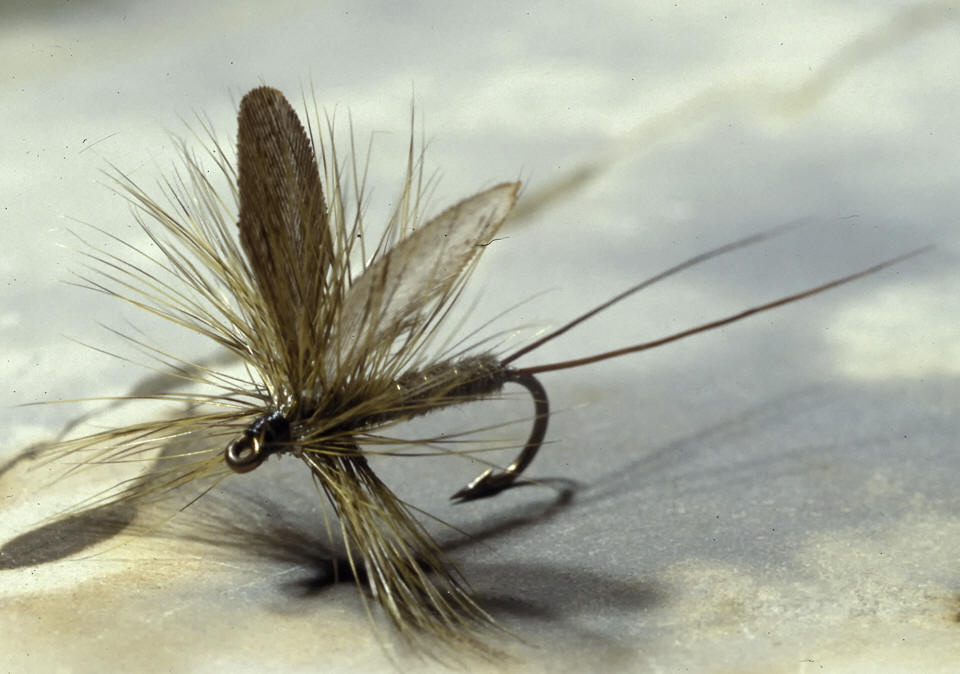
No 1
Hook : Daiichi 1280 size 12 in Norway, Sweden and Finland (Central Europe and Denmark size 14-16)
Thread : Uni 8/0 gray, olive or tan
Tail : Two very fine brown Peccary fiber tips (20mm long) or dark tan colored spinner tails or micro fibetts as substitute.
Body : Gray Heron fibers dyed olive
Rib : Extra fine gold wire
Wings : Greyish brown duck body feather burned with wing burners (13mm long)
Hackle : Grizzly hackle dyed olive
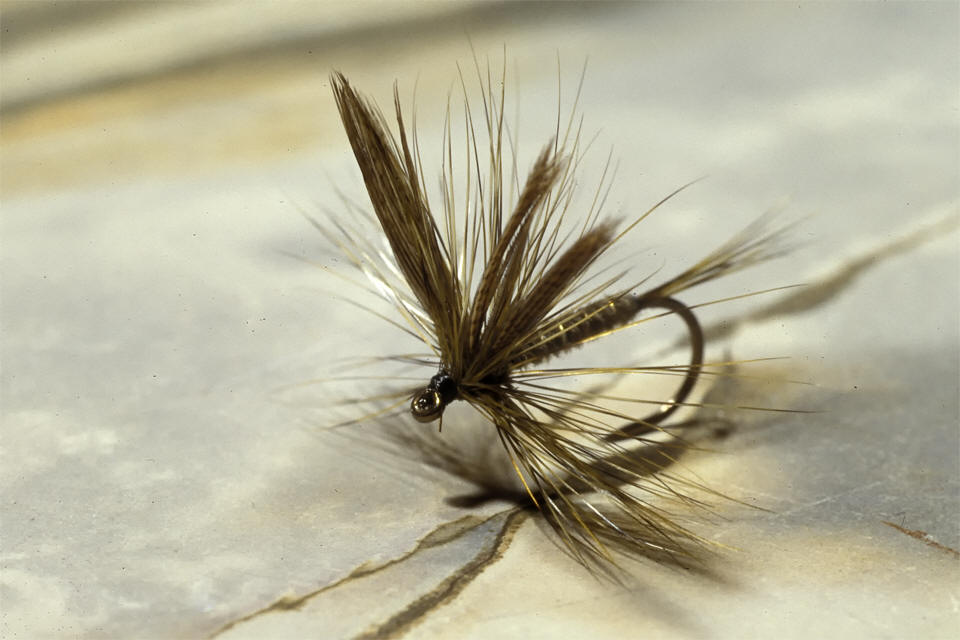
No 1A
Hook : Daiichi 1280 size 12 (Central Europe 14-16)
Thread : Uni 8/0 gray, olive or tan
Tail : Grizzly hackle fibers dyed olive
Body : GRE Heron fibers dyed olive
Rib : Extra fine gold wire
Wings : Just grayish brown duck body fibers tie in and split in two sections
Hackle : Grizzly hackle dyed olive
Note: It was Philip White, the River Keeper, who gave me the idea to tie in the wing over the hackle. I was so impressed by this tying technique that I tried it myself with considerable success. Thanks to Philip, I made a complete new series of Mayflies based on this technique. One of them is the Green Glomma Dun No 2.
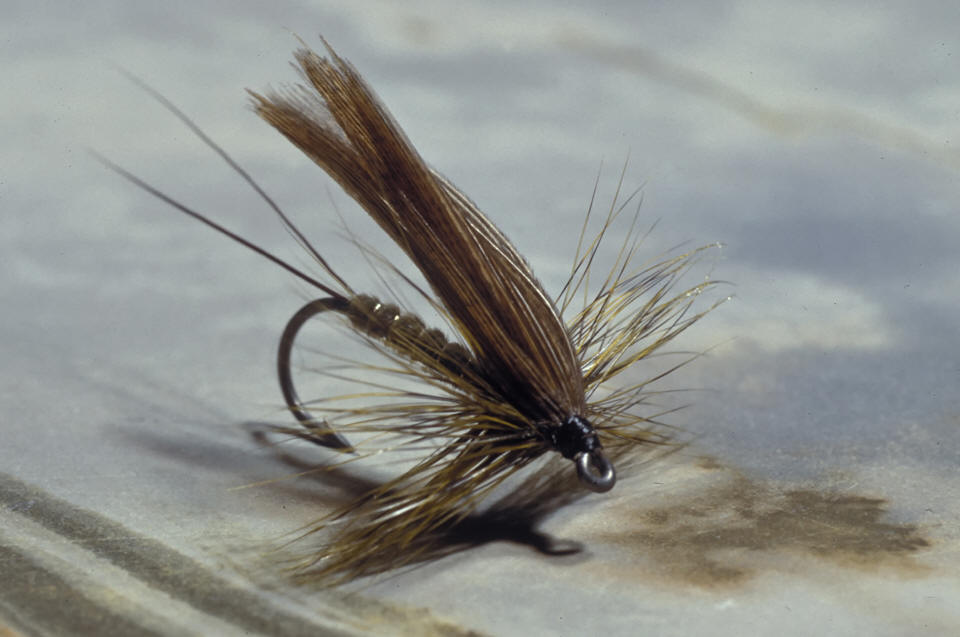
No 2
Hook : Daiichi 1280 size 12 (Central Europe 14-16-18)
Thread : S Uni 8/0 gray, olive or tan
Tail : Two brown Peccary fiber tips (20mm long) or spinnertails as substitute
Body : GRE Heron fibers dyed olive
Rib : Extra fine gold wire
Hackle : Grizzly hackle dyed olive
Wings : Just grayish brown duck body fibers, tied in over the wing
Head : Black
Note: For those three flies, I use the redundant heron fibers to tie up the hackle. In practice, instead of the more fragile heron, it is better to use a small piece of poly yarn for trout fishing, because the fine, sharp teeth of a wild trout will damage this fly easily.
My third and last pattern is based on a parachute style, but this pattern floats higher on the water.
No 3
Hook : Partridge Swedish Dry fly Hook size 12 (Central Europe 14-16-18)
(This pattern is not tied in the upside down style)
Thread : Uni 8/0 gray, olive or tan
Tail : Two brown Peccary fiber tips (20mm long) or spinnertails as substitute
Body : Fly-rite colors 42 and 43, mixed 50-50 to get the Gary Borger Color
System #100
Rib : Monofilament
Hackle : Grizzly hackle dyed olive
Wings : Just grayish brown duck body fibers tied in and split into two parts
Thorax : Same as body or peacock herl
Head : Black
Tying instructions
Step 1
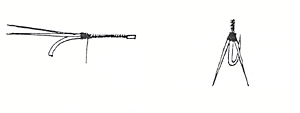
Tie in two peccary fibers and split
Step 1A
Tie in two spinnertail fibers with the points toward the eye. Make a small round tag with your tying thread, and pull the tips back over the hook shank in the proper position by holding them on the left and right sides of the hook shank. The tag will split the fibers perfectly.
Secure the tails with your thread, and you will see that the tails will stay in the right position, and a nice V shape will be easily realized.
If you want to make a fly with three tails, I will advise you to use this technique exclusively. Again you tie in three micro fibetts with the tips pointed towards the hook eye. Now, pull one fiber over the hook shank to make the middle tail. Be sure the fiber is tied exactly at the top of the hook’s shank, and pointed directly in the middle. Secure the fiber, and make a small tag at the end of the hook shank, close to the bend. Then pull the two other fibers backward, and secure them with your thread left and right on the hook shank. The tag will split your tail. If you do it correctly, you will have a perfect tail split, in three sections. Every fly tier who saw this technique was very impressed with it.
Step 2
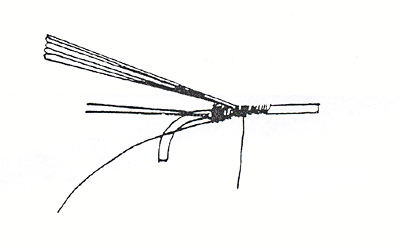
Tie in the ribbing and heron herls as shown in drawing above
Step 3
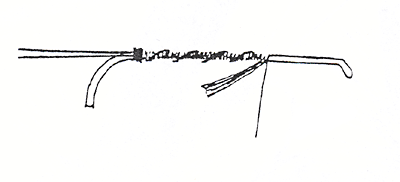
Make the body, and secure with the ribbing. Tie back the redundant heron herls
Step 3A
If you make a trout fly, you can tie in a small piece of poly yarn
Step 4
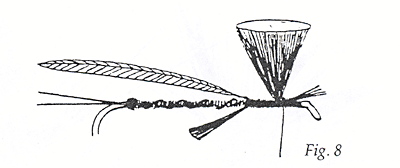
Tie in the hackle and wing
Step 5 and Step 6
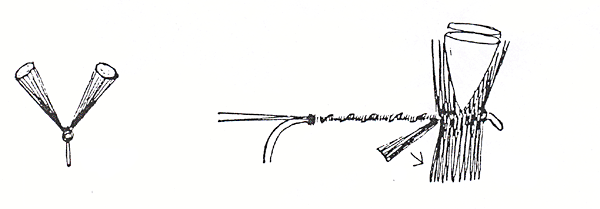
Split the wing and tie in the hackle, and pull the heron herl or poly yarn forward, through the hackle
Step 7
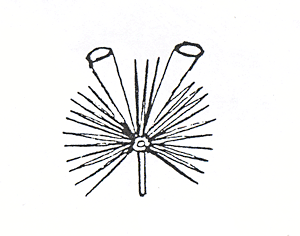
The completed fly
